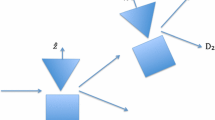Summary
A simple extension to Bell’s theorem is presented. The introduction of an additional assumption is found to lead to a familiar type of causality paradox. This necessitates two surprising conclusions,viz. i) that the paradox in question can only be avoided by introducing a restriction which is not supported by the predictions of quantum mechanics and ii) that a well-known model for explaining the nonlocality indicated by Bell’s theorem must be considered untenable.
Riassunto
Si presenta una semplice estensione al teorema di Bell. Si trova che l’introduzione di un ulteriore presupposto porta ad un tipo familiare di paradosso di causalità. Ciò rende necessarie due conclusioni sorprendenti, cioè i) che il paradosso in questione può essere evitato solamente introducendo una restrizione che non rientra nelle previsioni della meccanica quantistica, ii) che un ben noto modello per spiegare la non località indicata dal teorema di Bell deve essere considerato inaccettabile.
Резюме
Предлагается простое обобщение теоремы Белла. Показывается, что введение дополнительного предложения приводит к известному типу парадокса причинности. Это неизежно приводит к двум неожиданным выводам: 1) указанный парадокс можно обойти только с помощью введения ограничения, которое не подтверждается предсказаниями квантовой механики; 2) хорошо известная модель для объяснения нелокальности, следующая из теоремы Белла, является несостоятельной.
Similar content being viewed by others
References
J. S. Bell:Physics,1, 195 (1965).
J. F. Clauser andA. Shimony:Rep. Prog. Phys.,41, 1881 (1978);A. Aspect, J. Dalibard andG. Roger:Phys. Rev. Lett.,49, 1804 (1982).
For the question of other possible assumptions involved, seeJ. F. Clauser andA. Shimony:Rep. Prog. Phys.,41, 1881 (1978);B. d’Espagnat:Sci. Am.,241(5), 128 (1979);H. P. Stapp:Found. Phys.,10, 767 (1980).
It is easily shown, however, that this effect cannot be used as a means for communicating between observers (see,e.g.,T. M. Helliwell andD. A. Konkowski:Am. J. Phys.,51, 996 (1983)).
This is, in fact, all that we can mean by the term «nonlocality» in the present context. Of course, of the many particles measured, there is no way for us to know which ones would have yielded different values in different circumstances. Nevertheless, the existence of the nonlocal effect can be established indirectly from the overall statistical results, as Bell’s proof demonstrates.
By symmetry, presumably any pair of different directions would do, although Bell’s theorem only requires that the statement in italics be true for at least some pairs of directions.
If theM 1 measurement may be in either of the two directions ω1 and ω2, every particle arriving atM 2 must correspond to one of the four possibilities shown in table I (although it is not possible for us to know, either before or after our measurements, which possibility is, or was, the right one for a particular particle). The statistical predictions of quantum mechanics imply that the last two possibilities in the table must sometimes occur for at least some initial choice of directions ω1, ω2.
There may be external influences other than theM 1 measurement which have an effect on the result of theM 2 measurement (e.g. the state of the apparatus atM 2). What is being stated is thatM 2 would yield+1/2ħ ifω 1 were chosen atM 1, whereasM 2 would yield −1/2ħ ifω 2 were chosen atM 1,taking any other influences to be the same in both cases.
It is perhaps worth stressing the point that there is no suggestion of our being able to choose a particular, desired result atM 2 by means of an appropriate choice of direction atM 1; nor is there any suggestion of our being able to send a signal to an observer atM 2 by means of our choice atM 1: neither of these abilities is necessary in order to produce a paradox. The predictions of quantum mechanics imply that some of the pairs of particles passing through our apparatus must conform (without our knowledge) to the required condition for a paradox, namely that +1/2ħ would be found atM 2 for one choice of direction atM 1, whereas −1/2ħ would be found atM 2 for a different choice of direction atM 1. Hence, if we set up the experiment as described and try various pairs of directions, the paradox must arise sometimes, on unpredictable occasions.
O. Costa de Beauregard:Nuovo Cimento B,42, 41 (1977);51, 267 (1979);W. C. Davidon:Nuovo Cimento B,36, 34 (1976);C. W. Rietdijk:Found. Phys.,8, 615 (1978);J. G. Cramer:Phys. Rev. D,22, 362 (1980);R. I. Sutherland:Int. J. Theor. Phys.,22, 377 (1983).
Author information
Authors and Affiliations
Additional information
Traduzione a cura della Redazione.
Переведено редакцией.
Rights and permissions
About this article
Cite this article
Sutherland, R.I. A corollary to Bell’s theorem. Nuov Cim B 88, 114–118 (1985). https://doi.org/10.1007/BF02728894
Received:
Revised:
Published:
Issue Date:
DOI: https://doi.org/10.1007/BF02728894



